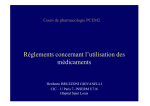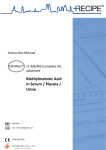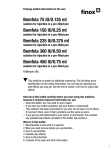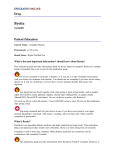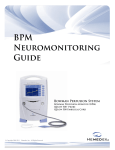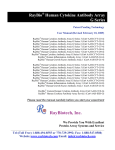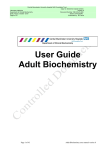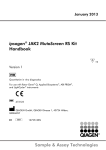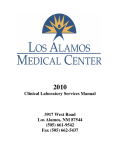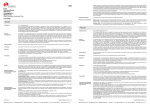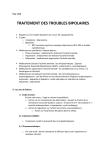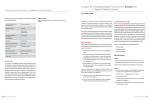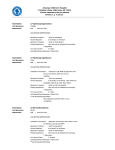Download GENERAL COLLECTION PROCEDURES
Transcript
GENERAL SPECIMEN COLLECTION PROCEDURES ABBEVILLE GENERAL HOSPITAL LABORATORY TABLE OF CONTENTS I. SPECIMEN PREPARATION AND HANDLING INTRODUCTION A. PLASMA B. WHOLE BLOOD C. SERUM D. URINE E. STORAGE AND TRANSPORT II. LABELING OF SPECIMENS A. CRITERIA FOR REJECTION III. SPECIMEN REQUIREMENTS (TABLE) IV. BLOOD BANK TYPENEX PROCEDURE V. BACTERIOLOGY A. AEROBIC CULTURES 1. THROAT SWABS 2. SPUTUM 3. URINE 4. VAGINAL/CERVICAL/URETHRAL 5. STOOL 6. CEREBROSPINAL FLUID (CSF) 7. SYNOVIAL (JOINT) FLUID 8. BLOOD CULTURES 9. WOUNDS/ABSCESSES/EXUDATES 10. MRSA SCREENING 11. EYE/EAR/SINUS CULTURES B. ANAEROBIC CULTURES 1. ANAEROBIC CULTURE TRANSPORT 2. GUIDELINES FOR ANAEROBIC CULTURE VI. VIROLOGY SPECIMEN COLLECTION PROCEDURES A. INFLUENZAE TESTING B. RSV TESTING VII. PARASITOLOGY SPECIMEN COLLECTION PROCEDURES VIII.OTHER SPECIMEN COLLECTION PROCEDURES (MISCELLANEOUS) 1 BACK TO TOP I. SPECIMEN PREPARATION AND HANDLING - INTRODUCTION Proper specimen collection, preparation, and handling are imperative to ensure valid laboratory results. Improper technique in obtaining and preserving specimens may yield false analytical values. The following information summarizes our recommendations for collecting, handling, and preserving specimens. In order that the results of analysis truly reflect the patient’s condition, we suggest that these recommendations be followed closely. Also in this directory, specific specimen requirements for each test are given, and these must be followed carefully. Please call the laboratory if you have any questions about obtaining a valid specimen for the test desired. Blood specimens will be drawn for procedures requiring plasma, serum or whole blood. The tops of collection tubes are color coded according to the anticoagulant or preservative (plasma), or lack thereof (serum). In the alphabetical listing of tests, the proper tube is indicated by anticoagulant used or as a specific quantity of serum (red top). The following table is provided as a guide to the anticoagulant / preservative in the various collection tubes. A. Plasma - Most chemistry tests processed here at AGH require clear, unhemolyzed plasma obtained from green top tubes. (Red topserum may be used as well) The required green top tube for chemistry testing at AGH contains Lithium Heparin as the anticoagulant and has a gel separator included. The gel containing plasma separator tube is preferred over the non-separator due to its preservative properties; removing plasma from the red cells reduces/eliminates metabolism of analytes tested, thus preserving the accurate analytical value. If possible, immediately centrifuge the tube at 3500 rpm for 15 minutes. If a gel separator tube is not used, i.e. in the case of coagulation tests in a blue top tube, the plasma only (no red cells) must be decanted and pipetted into a capped transport tube. Properly label the tube with the patient’s name, date of birth, current date and time of collection. Send specimen directly to AGH lab for processing. If you are not able to separate the plasma from the red cells either by centrifugation and removing the plasma or by 2 BACK TO TOP centrifuging a plasma separator tube, it is important that the specimen be transported to the laboratory immediately after collection. PLASMA / WHOLE BLOOD TUBES: GREEN TOP: CHEMISTRY TESTING BLUE TOP: COAGULATION LITHIUM HEPARIN SODIUM CITRATE PURPLE TOP: HEMATOLOGY EDTA PINK TOP: BLOOD BANK 3 BACK TO TOP GREY CAP: LACTIC ACID TESTING (MUST BE COLLECTED ON ICE AND IMMEDIATELY PROCESSED) SODIUM FLUORIDE/ POTASSIUM CITRATE B. Whole blood - For collecting whole blood fill the proper color-coded tube and mix immediately by slowly inverting the tube 8-10 times. Do not centrifuge the tube. C. Serum - Chemistry testing, Serology testing, and most reference lab testing may require serum. For collecting specimens, completely fill the required red top tube. Allow the tube to clot for at least 15 minutes, then centrifuge for 15 minutes at approximately 3500 rpm. Place the serum in a transfer tube (if not on gel) using either a clean disposable transfer pipette or by carefully decanting. Cap the transfer tube securely and label with the patient’s name, date of birth, date and time of collection. If you are not able to separate the serum from the red cells by centrifugation and removing the serum, it is important that the specimen be transported to the laboratory immediately after collection. 4 BACK TO TOP SERUM TUBES: RED TOP (PLAIN/SST): CHEMISTRY, SEROLOGY, SEND OFF TESTING, ETC. NO ANTICOAGULANT *MOST OF THE TIME, A YELLOW RING ON TOP OF THE CAP WILL INDICATE THAT THE TUBE CONTAINS A GEL SEPARATOR, A WHITE RING WILL INDICATE THAT IT IS A SHORT SAMPLE TUBE, AND A BLACK RING WILL INDICATE THAT A TUBE HAS NO GEL. *SHORT DRAW TUBE*- USE CAUTION AS MOST DO NOT CONTAIN GEL NOR MAY THEY MEET MINIMUM SPECIMEN VOLUME REQUIREMENTS… DIRECT ANY QUESTIONS ON SPECIMEN COLLECTION REQUIREMENTS TO AGH LAB AT 337-898-6475. When blood is collected, fill the labeled proper color-coded tube completely with blood to ensure the correct ratio of specimen to anticoagulant/preservative. (The exception to this is the blue top citrated tube which is a partial draw tube. Allow the tube to fill until the vacuum of the tube is depleted to assure proper volume. It is very critical for coagulation testing that the tube be allowed to fill to the appropriate volume.) Immediately after filling, invert all tubes slowly 8-10 times to thoroughly mix the blood and the anticoagulant. Avoid vigorous mixing which can cause hemolysis and adversely affect some tests results. Instructions for proper blood drawing (phlebotomy) are available from our laboratory on request. 5 BACK TO TOP Some tests require special patient preparations, fasting states, or timing of samples. It is important that these requirements are followed in order for the test results to be meaningful to the physician interpreting the results. Specimen requirements for blood samples will be listed as Plasma, Serum, or Whole Blood. D. URINE COLLECTION - Collection of urine should be into chemically clean receptacle, tightly sealed, and labeled with the patient’s name, date of birth, and date and time of collection. Some procedures may require timed specimens or samples collected over a 24 hour period. Urine collection for culture and sensitivity will be outlined below in bacteriology section. E. STORAGE AND TRANSPORT Specimens should be transported to the laboratory immediately after collection. If the serum or plasma will be separated from the red cells before being sent to the laboratory, the table will indicate the proper storage temperature. If the serum or plasma cannot be separated, contact the laboratory for instructions. Frozen specimens - Some specimens should be frozen soon after collection if testing will be delayed. Serum or plasma can only be frozen after they have been centrifuged and placed in a plastic transfer tube. NEVER FREEZE A TUBE WHICH STILL CONTAINS RED BLOOD CELLS NEVER FREEZE A GLASS TUBE 6 BACK TO TOP II. LABELING OF SPECIMENS In order to assure positive identification and optimum integrity of patient specimens from the time of collection until testing has been completed and results reported, all specimens submitted to AGH laboratory for testing must be labeled with the patient name and a unique identifying number. In general, it would always be acceptable to use name and date of birth. Multiple samples from the same patient on the same day should also be labeled with the time of collection or site specific information as appropriate. Accrediting agencies require the laboratory to reject a specimen for analysis if there is no identification on the specimen. Collectors will be notified of inappropriately labeled specimens. A. CRITERIA FOR REJECTION Specimens collected according to the requirements in the procedure list will be acceptable for analysis. Specimens not collected according to guidelines may be subject to rejection. The collection site or physician will be notified immediately of the rejection. A specimen collection deficiency report will be filled out on these specimens and determinations will be made as to whether the patient’s treatment was compromised. Some criteria for rejection of specimens are: • • • • • • • • • • • • • Unlabeled specimens Improperly labeled specimens Specimens received without requests Incomplete or incorrect test request form (e.g., no test marked) Test order without a specimen Grossly hemolyzed blood Clots in an anticoagulated tube Compromised specimens (e.g., grossly contaminated) Leaky containers Improper storage of specimens Inappropriately collected specimens Insufficient quantity Specimens submitted in incorrect or expired transport media 7 BACK TO TOP III. SPECIMEN REQUIREMENTS: The following table lists specimen requirements by test name. Additional specific specimen collection procedures follow the table when indicated. SERUM - UNLESS SPECIFICALLY INDICATED, EITHER A PLAIN RED OR A RED SERUM SEPARATOR TUBE MAY BE USED. (PLAIN RED IDICATES THAT SERUM SEPARATOR TUBES SHOULD NOT BE USED.) GREEN TOP – INDICATES LITHIUM HEPARIN ANTICOAGULANT UNLESS NOTED. RED TOP – INDICATES ANY RED TOP TUBE UNLESS NOTED. LABCORP REFERENCE LABORATORY (REF LAB)- SEE LINK BELOW FOR ALL SPECIMEN REQUIREMENTS https://www.labcorp.com/wps/portal/provider/testmenu R = SPECIMENS REFERRED TO REFERENCE LABS. INFORMATION ON TESTING SCHEDULES CAN BE OBTAINED BY CALLING THE LABORATORY. TEST NAME ACETAMINOPHEN ACETONE, SERUM ACETONE, URINE ACID PHOSPHATASE ACTH ACTIN/SMOOTH MUSCLE ANTIBODY AFB CULTURE AND STAIN ALBUMIN ALCOHOL, ETHYL RESULTS AVAILABLE SAME DAY SAME DAY SAME DAY R R R R SAME DAY SAME DAY ALKALINE PHOSHPATASE (ALP) SAME DAY ALPHA-FETOPROTEIN (MATERNAL) ALPHA-FETOPROTEIN R R SPECIMEN REQUIREMENTS GREEN OR RED TOP GREEN OR RED TOP URINE - 5 ML ANY RED TOP PURPLE TOP (EDTA PLASMA) RED TOP SPUTUM, BRONCHIAL WASH, ETC. Refrigerate GREEN OR RED TOP GREEN OR RED TOP CLEAN SKIN WITH A DISINFECTANT OTHER THAN ALCOHOL GREEN OR RED TOP RED TOP SUBMIT PRENATAL AFP REQUEST FORM RED TOP 8 BACK TO TOP TEST NAME (TUMOR MARKER) ALPHA-FETOPROTEIN WITH L3% ALT AMIKACIN, PEAK RESULTS AVAILABLE R SAME DAY R SPECIMEN REQUIREMENTS RED TOP R GREEN OR RED TOP PLAIN RED TOP (NO GEL): COLLECT WITHIN 15 MINUTES AFTER A 60 MINUTE INFUSION, 30 MINUTES AFTER A 30 MIN. INFUSION. PLAIN RED TOP (NO GEL): COLLECT PREDOSE GREEN TOP PLACE SPECIMEN ON ICE AFTER COLLECTION *SEND TO LAB IMMEDIATELY* GREEN OR RED TOP URINE – 10 ML - COLLECT A TIMED TWO HOUR SPECIMEN OR 24 HOUR URINE. REFRIGERATE DURING COLLECTION. RED TOP R RED TOP R R R BLUE TOP GREEN OR RED TOP RED TOP TUBE BASIC METABOLIC PANEL BILIRUBIN, CONJUGATED BILIRUBIN, DIRECT SAME DAY GREEN OR RED TOP BILIRUBIN, TOTAL SAME DAY BLEEDING TIME BLOOD TYPE & RH SAME DAY SAME DAY BLOOD UREA NITROGEN BNP SAME DAY BUN SAME DAY AMIKACIN, TROUGH AMMONIA R SAME DAY AMYLASE AMYLASE, URINE SAME DAY SAME DAY ANGIOTENSINCONVERTING ENZYME (ACE) ANA (ANTI-NUCLEAR ANTIBODIES) ANTITHROMBIN III AST BARTONELLA ANTIBODY PROFILE: (CAT SCRATCH SEROLOGY) SEE: BILIRUBIN, DIRECT SAME DAY GREEN OR RED TOP PROTECT FROM LIGHT GREEN OR RED TOP PROTECT FROM LIGHT SEND PATIENT TO LABORATORY PINK OR PURPLE TOP: SEE TYPENEX PROCEDURE BELOW SEE: BUN GREEN TOP: NT-PRO BNP (IN HOUSE) PURPLE TOP: BNP (REF LAB) GREEN OR RED TOP 9 BACK TO TOP CBC TEST NAME RESULTS AVAILABLE SAME DAY C-REACTIVE PROTEIN, QUANTITATIVE C-REACTIVE PROTIEN, CARDIAC, HIGH SENS. C. DIFFICILE TOXIN SAME DAY C.S.F. ANALYSIS SAME DAY CA 125 CA 15-3 CA 19-9 CA 27.29 CAFFEINE CALCIUM CARBAMAZAPINE CARBON DIOXIDE CCP ANTIBODIES, IGA, IGG CEA CARCINOEMBRYONIC AG. CHLAMYDIA CULTURE R R R R R SAME DAY SAME DAY SAME DAY R CHLAMYDIA PROBE BY GEN PROBE R CHLORIDE, SERUM CHOLESTEROL CHOLINESTERASE CHOLINESTERASE, RBC CK CKMB CL CLINITEST, URINE SAME DAY SAME DAY R R SPECIMEN REQUIREMENTS PURPLE TOP: 24 HRS ROOM TEMP, 36 HRS REFRIGERATED R RED TOP R RED, PURPLE, OR GREEN TOP: SEND IMMEDIATELY AFTER COLLECTION STOOL – MINIMUM 2 GRAMS CSF IN 4 STERILE TUBES IMMEDIATELY TRANSPORT TO THE LABORATORY - DO NOT REFRIGERATE RED TOP RED TOP RED TOP RED TOP PLAIN RED TOP (NO GEL) GREEN OR RED TOP PLAIN RED TOP (NO GEL) GREEN OR RED TOP RED TOP (GEL RECOMMENDED) R RED TOP TUBE R ENDOCERVICAL OR URETHRAL SWAB COLLECTED WITH CULTURETTE PLACED IN CHLAMYDIA TRANSPORT MEDIA: SEE BACTERIOLOGY SECTION BELOW. APTIMA UNISEX SWAB TRANSPORT KIT: SAME DAY SAME DAY GREEN OR RED TOP GREEN OR RED TOP RED AND/OR PURPLE TOP PURPLE TOP SEE: CPK GREEN OR RED TOP SEE: CHLORIDE RANDOM URINE, REFRIGERATE 10 BACK TO TOP TEST NAME CLO TEST CLOZAPINE (CLOZARIL) CMV - (CYTOMEGALOVIRUS ANTIBODIES) CO2 COAG FACTOR ASSAYS COMPLEMENT, C3 COMPLEMENT, C4 COMPLEMENT, TOTAL COMPREHENSIVE METABOLIC PANEL COOMBS, DIRECT COOMBS, INDIRECT RESULTS AVAILABLE 1 DAY R R R R R R SAME DAY SAME DAY SAME DAY COPPER, SERUM R CORTISOL, A.M. CORTISOL, P.M. CORTISOL, URINARY FREE CPK CREATININE CLEARANCE R R R SAME DAY SAME DAY CREATININE CREATININE, URINE CROSS MATCH SAME DAY SAME DAY SAME DAY CRYPTOSPIRIDIUM, EIA CSF CELL COUNT CSF GLUCOSE CSF PROTEIN CULTURE, BLOOD CULTURE, SPUTUM R SAME DAY SAME DAY SAME DAY 1 - 5 DAYS 1 - 3 DAYS SPECIMEN REQUIREMENTS BIOPSY IN CLO TEST MEDIA PLAIN RED TOP (NO GEL) RED TOP SEE: CARBON DIOXIDE BLUE TOP: 2 ML FOR EACH FACTOR REQUESTED RED TOP RED TOP RED TOP GREEN OR RED TOP PINK OR PURPLE TOP PINK OR PURPLE TOP: SEE TYPENEX PROCEDURE BELOW ROYAL BLUE TOP TUBE-NO ANTICOAGULANT RED TOP - COLLECT AT 8:00 A.M. RED TOP - COLLECT AT 4:00 P.M. USE JUG CONTAINING BORIC ACID (SUPPLIED BY LABCORP) GREEN OR RED TOP 24 HOUR URINE - KEEP ON ICE (ALSO NEED GREEN OR RED TOP COLLECTED DURING COLLECTION OF URINE) SEE: PATIENT EDUCATION SERIES GREEN OR RED TOP URINE - 10 ML PINK OR PURPLE TOP SEE: BLOOD BANK TYPENEX PROCEDURE STOOL – 2mL or 2g CSF - 1 ML CSF - 1 ML CSF - 1 ML SEE: BACTERIOLOGY SPECIMENS - BLOOD SEE: BACTERIOLOGY SPECIMENS – SPUTUM 11 BACK TO TOP TEST NAME CULTURE, STOOL CULTURE, THROAT CULTURE, URINE D - DIMER DEPAKANE DHEA-SULFATE DIFFERENTIAL WBC COUNT DIGOXIN RESULTS AVAILABLE SPECIMEN REQUIREMENTS 1 - 3 DAYS 1 - 3 DAYS 1 - 3 DAYS SAME DAY SAME DAY R SAME DAY SEE: BACTERIOLOGY SPECIMENS - STOOL SEE: BACTERIOLOGY SPECIMENS – THROAT SEE: BACTERIOLOGY SPECIMENS - URINE GREEN TOP SEE: VALPROIC ACID RED TOP PURPLE TOP SAME DAY DILANTIN dsDNA ANTIBODIES DRUG SCREEN - URINE ELECTROLYTES ENDOMYSIAL AB IGA EOSINOPHIL COUNT EPSTEIN-BARR VIRUS (EBV) ACUTE ANTIBODIES ESR - ERYTROCYTE SEDIMENTATION RATE SAME DAY R SAME DAY SAME DAY R SAME DAY R GREEN OR RED TOP COLLECT PREDOSE OR AT LEAST 8 HOURS POST DOSE SEE: PHENYTONIN RED TOP URINE - 10 ML GREEN OR RED TOP RED TOP PURPLE TOP RED TOP SAME DAY PURPLE TOP ESTRADIOL ESTROGEN ETHYL ALCOHOL (ETOH) FECAL FAT QUALITATIVE FECAL FAT QUANTITAIVE FECAL LEUCOCYTE STAIN FERRITIN FIBRINOGEN FLU TEST R R SAME DAY RED TOP GREEN OR RED TOP SEE: ALCOHOL, ETHYL STABLE 4 HOURS AT ROOM TEMP STABLE 12 HOURS REFRIGERATED R STOOL – 3 GRAMS MINIMUM R CONTACT LAB FOR SPECIMEN COLLECTION MATERIALS STOOL - RANDOM SAME DAY SAME DAY SAME DAY SAME DAY RED TOP BLUE TOP NASAL WASHING OR NASAL/NASOPHARYNGEAL SWAB (GREEN CAP) 12 BACK TO TOP TEST NAME RESULTS AVAILABLE FOLIC ACID FOLIC ACID, RBC FOLLICLESTIMULATING HORMONE (FSH) FTA-ABS G-6PD GASTROCCULT GENTAMYCIN, PEAK R R SAME DAY SAME DAY GENTAMYCIN, TROUGH SAME DAY GGT-GAMMA GLUTAMYL TRANSPEPTIDASE GIARDIA ANTIGEN GLIADIN AB IGA GLIADIN AB IGG GLUCOSE TOLERANCE GLUCOSE, 2 HOUR POST PRANDIAL GLUCOSE GLUCOSE, URINE GLUTAMIC ACID DECARBOLYLASE (GDA) GLYCOHEMOGLOBIN GRAM STAIN GROUP B CULTURE R R R R SPECIMEN REQUIREMENTS RED TOP 2 PINK TOPS- FILLED RED TOP RED TOP 2 PURPLE TOPS - FILLED EMESIS/GASTRIC ASPIRATE GREEN OR RED TOP COLLECT WITHIN 15 MINUTES AFTER A 60 MINUTE INFUSION 30 MINUTES AFTER A 30 MIN. INFUSION GREEN OR RED TOP COLLECT PREDOSE GREEN OR RED TOP R R R SAME DAY SAME DAY STOOL – 2 GRAM MINIMUM RED TOP RED TOP SEE: SPECIAL PROCEDURES GREEN OR RED TOP SAME DAY SAME DAY R GREEN OR RED TOP URINE, RANDOM - 10 ML SAME DAY 1 - 3 DAYS SEE: HEMOGLOBIN A1C PREPARED SLIDE OR PRIMARY SPECIMEN WHITE CAPPED SWAB –VAGINAL/ANORECTAL AREA 13 BACK TO TOP TEST NAME RESULTS AVAILABLE GROWTH HORMONE H. PYLORI ANTIBODY H. PYLORI ANTIGEN HCG QUALITATIVE HCG - QUANTITATIVE HDL CHOLESTEROL HEMATOCRIT R SAME DAY R SAME DAY SAME DAY SAME DAY SAME DAY HEMOGLOBIN ELECTROPHORESIS HEMOGLOBIN HEMOGLOBIN A1C HEPATIC PANEL HEPATITIS A ANTIBODY HEPATITIS B SURFACE ANTIGEN - HBSAg HEPATITIS B CORE ANTIBODY, TOTAL HEPATITIS B CORE ANTIBODY, IGM HEPATITIS B SURFACE ANTIBODY - HBSAb HEPATITIS C VIRUS ANTIBODY HCV RT-PCR, QUANTITATIVE HEPATITIS PANEL HIV 1,2 HIV-RAPID (POST EXPOSURE ONLY) IgA IgE IgG IgM R SAME DAY SAME DAY SAME DAY R SPECIMEN REQUIREMENTS RED TOP RED TOP STOOL – 2mL or 2g RED TOP GREEN OR RED TOP GREEN OR RED TOP PURPLE TOP PURPLE TOP PURPLE TOP PURPLE TOP GREEN OR RED TOP RED OR PURPLE TOP R RED TOP R RED OR PURPLE TOP R RED OR PURPLE TOP R RED TOP R RED OR PURPLE TOP R PURPLE TOP R R SAME DAY R R R R RED TOP RED TOP FINGERSTICK OR PURPLE TOP RED RED RED RED 14 TOP TOP TOP TOP BACK TO TOP TEST NAME IMMUNOGLOBULINS, IgA+IgG+IgM INDIA INK PREP INSULIN IRON IRON BINDING CAPACITY K+ KEPPRA KOH PREP LEUKOCYTE ALKALINE PHOSPHATASE STAIN (LAP) LUTEINIZING HORMONE (LH) LD LDH LDH ELECTROPHORESIS LDL RESULTS AVAILABLE R R R SAME DAY SAME DAY RED TOP SPECIMEN REQUIREMENTS CSF - 1 ML RED TOP RED TOP RED TOP R R SEE: POTASSIUM SEE: LEVTIRACETAM SWAB OR PRIMARY SPECIMEN IN KOH GREEN TOP R RED TOP SAME DAY R SAME DAY SEE: LDH GREEN OR RED TOP RED TOP GREEN OR RED TOP PATIENT MUST BE FASTING ROYAL BLUE – WHOLE BLOOD WITH ANTICOAGULANT LEAD R LEVETIRACETAM (KEPPRA) LH - (LEUTINIZING HORMONE) LIDOCAINE LIPASE LIPID PROFILE R PLAIN RED TOP (NO GEL) R RED TOP R SAME DAY SAME DAY LITHIUM SAME DAY PLAIN RED TOP (NO GEL) GREEN OR RED TOP GREEN OR RED TOP PATIENT MUST BE FASTING PLAIN RED TOP (NO GEL) COLLECT PREDOSE 15 BACK TO TOP TEST NAME LIVER PROFILE LUPUS PANEL MAGNESIUM MALARIA PREP METHYLMALONIC ACID MYCOPLASMA IGG MYCOPLASMA IGM MITOCHONDRIAL ANTIBODY, M2 MONOSPOT MUMPS ANTIBODIES, IgG Na+ O’SULLIVAN SCREEN OCCULT BLOOD, STOOL OCP - (STOOL FOR OVA, CYSTS & PARASITES) OSMOLALITY, SERUM OSMOLALTIY, URINE OXCARBAZEPINE (TILEPTAL) PANCREASTATIN PAP SMEAR PHENOBARBITOL RESULTS AVAILABLE R SAME DAY R R R R R SAME DAY R See: HEPATIC PANEL RED TOP GREEN OR RED TOP PURPLE TOP - 5 ML AND 2 THIN AND THICK SMEARS RED TOP RED TOP RED TOP RED TOP GREEN OR RED TOP RED TOP R SEE: SODIUM GREEN OR RED TOP SEE: PATIENT EDUCATION SERIES STOOL SEE: PATIENT EDUCATION SERIES STOOL - 10 GRAMS - FRESH, RANDOM, R R R RED TOP URINE - 25 ML – RANDOM PLAIN RED TOP (NO GEL) OR PURPLE TOP R COLLECT IN “Z” PRESERVATIVE TUBE CONTACT LAB FOR INSTRUCTIONS FIXED SMEAR PLAIN RED TOP (NO GEL) COLLECT PREDOSE GREEN OR RED TOP COLLECT PREDOSE GREEN OR RED TOP PINWORM SLIDE CAPILLARY BLOOD ON PKU CARD PURPLE TOP GREEN OR RED TOP: AVOID HEMOLYSIS, PROLONGED TOURNIQUET APPLICATION, AND EXCESSIVE FIST CLENCHING RED TOP SAME DAY SAME DAY R R PHENYTOIN SAME DAY PHOSPHORUS PIN WORM PREP PKU PLATELET COUNT POTASSIUM SAME DAY SAME DAY R SAME DAY SAME DAY PREALBUMIN SPECIMEN REQUIREMENTS R 16 BACK TO TOP TEST NAME PRIMIDONE PROCAINAMIDE PROCALCITONIN PROGESTERONE PROGRAF PROINSULIN PROLACTIN PROTEIN ELECTROPHORESIS, SERUM OR URINE PROTEIN, TOTAL PROTEIN, URINE PSA - (PROSTATIC SPECIFIC ANTIGEN) PT - PROTHROMBIN TIME PTH , INTACT PTH, PLUS CALCIUM PTT - PARTIAL THROMBOPLASTIN TIME QUAD SCREEN, (AFP-TETRA) QUANTITATIVE HCG QUINIDINE RAPAMUNE RHEUMATOID ARTHRITIS (RA) FACTOR RENAL PANEL RESULTS AVAILABLE R R R R R R SPECIMEN REQUIREMENTS PLAIN RED TOP PLAIN RED TOP RED TOP RED TOP SEE: TACROLIMUS RED TOP RED TOP SEE: SERUM PROTEIN ELECTROPHORESIS SEE: URINE PROTEIN ELECTROPHORESIS SAME DAY SAME DAY SAME DAY GREEN OR RED TOP URINE - 10 ML - COLLECT 24 HOUR URINE GREEN OR RED TOP SAME DAY BLUE TOP: TUBE MUST BE FILLED TO THE BLACK TRIANGLE INDICATOR. SPECIMENS BELOW THE INDICATOR LEVEL WILL BE REJECTED. CENTRIFUGE AND REMOVE PLASMA FROM CELLS IF POSSIBLE. DO NOT POUR MULIPLE TUBES TOGETHER. PURPLE TOP R SAME DAY R R R SAME DAY RED AND PURPLE TOP REQUIRED BLUE TOP: TUBE MUST BE FILLED TO THE BLACK TRIANGLE INDICATOR. SPECIMENS BELOW THE INDICATOR LEVEL WILL BE REJECTED. CENTRIFUGE AND REMOVE PLASMA FROM CELLS IF POSSIBLE. DO NOT POUR MULIPLE TUBES TOGETHER. 2 FULL RED GEL SEPARATOR TUBES – MATERNAL INFORMATION SHEET REQUIRED AS WELL SEE: HCG - QUANTITATIVE PLAIN RED TOP (NO GEL) SEE: SIROLIMUS RED TOP GREEN OR RED TOP 17 BACK TO TOP TEST NAME RESULTS AVAILABLE RUBELLA TITER, IGG ANTIBODIES RUBEOLA ANTIBODIES, IgG SALICYLATE R PURPLE TOP PURPLE TOP RED TOP STOOL - 2 ML RED OR PURPLE TOP NASOPHARYNGEAL WASHINGS OR GREEN CAPPED SWAB RED TOP R RED TOP RENIN RETICULOCYTE COUNT RETICULIN AGA AB ROTAVIRUS RPR RSV SED RATE SERUM PROTEIN ELECTROPHORESIS (SEP) SICKLE CELL SCREEN SIROLIMUS (RAPAMUNE) SODIUM SPECIFIC GRAVITY URINE SPERM COUNT SPINAL FLUID STOOL REDUCING SUBST SWEAT TEST T3, FREE T3, TOTAL T UPTAKE T4 T4, FREE T7 (TU+T4) TACROLIMUS (PROGRAF) TEGRETOL TESTOSTERONE, TOTAL TESTOSTERONE, FREE THEOPHYLLINE R SAME DAY R SAME DAY 1 - 3 DAYS SAME DAY SAME DAY SAME DAY R R R SAME DAY SAME DAY N/A SAME DAY N/A R R SAME DAY SAME DAY SAME DAY SAME DAY R SPECIMEN REQUIREMENTS GREEN OR RED TOP: COLLECT 1-3 HOURS POST DOSE SEE: ESR RED TOP PURPLE TOP PURPLE TOP GREEN OR RED TOP URINE - 12 ML Not performed at AGH lab. See: CSF ANALYSIS STOOL - 2 GRAMS - PROCESS WITHIN 1 HOUR AFTER COLLECTION Not performed at AGH lab RED TOP RED TOP GREEN OR RED TOP GREEN OR RED TOP GREEN OR RED TOP GREEN OR RED TOP PURPLE OR GREEN TOP R SEE: CARBAMAZAPINE RED TOP R R RED TOP PLAIN RED TOP (NO GEL) 18 BACK TO TOP TEST NAME RESULTS AVAILABLE THYROGLOBULIN ANTIBODY THYROGLOBULIN QUANTITATIVE TIBC TTG IGA (TISSUE TRANSGLUTAMINASE IGA) TTG IGG (TISSUE TRANSGLUTAMINASE – IGG) TRANSFERRIN SATURATION TRIAGE DRUG SCREEN R COLLECT IV DOSE - 30 MIN. AFTER COMPLETED ORAL DOSE - 2 HOURS POST DOSE RED TOP R RED TOP R SEE: IRON BINDING CAPACITY RED TOP R RED TOP SAME DAY RED TOP SEE: DRUG SCREEN (Urine) TRICHOMONAS PREP SAME DAY TRILEPTAL TRIGLYCERIDE SAME DAY THYROID PEROXIDASE (TPO) ANTIBODIES THYROID STIMULATING HORMONE (TSH) TYPE AND RH UCG URIC ACID URINALYSIS SPECIMEN REQUIREMENTS R VAGINAL SWAB PLACED IN A SMALL AMOUNT OF SALINE SEE: OXCARBAZEPINE GREEN OR RED TOP: PATIENT MUST BE FASTING RED TOP SAME DAY GREEN OR RED TOP SAME SAME SAME SAME PINK OR PURPLE TOP URINE - 12 ML, RANDOM GREEN OR RED TOP URINE - 12 ML STABLE 1 HOUR AT ROOM TEMP STABLE 24 HOURS REFRIGERATED URINE - 100 ML ALIQUOT OF A 24 HOUR URINE COLLECTION OR 10 ML RANDOM URIN GREEN OR RED TOP: COLLECT PREDOSE GREEN OR RED TOP: COLLECT 2 HOURS AFTER THE COMPLETION OF A 60 MINUTE I.V. GREEN OR RED TOP: DAY DAY DAY DAY URINE PROTEIN ELECTROPHORESIS VALPROIC ACID R SAME DAY VANCOMYCIN, PEAK SAME DAY VANCOMYCIN, SAME DAY 19 BACK TO TOP TEST NAME TROUGH VARICELLA-ZOSTER VIRUS (VZV), IgG VDRL, CSF VDRL, SERUM W/TITER VITAMIN A VITAMIN B1 (THIAMINE) VITAMIN B12 VITAMIN D, 25-OH VITAMIN E WBC WBC DIFFERENTIAL WSR ZINC RESULTS AVAILABLE R R R R R R R R SAME DAY R SPECIMEN REQUIREMENTS COLLECT PREDOSE RED TOP CSF - 1 ML RED TOP RED TOP (PROTECT FROM LIGHT) PATIENT MUST BE FASTING 8 HRS- CONTACT LAB FOR MORE INFORMATION. PURPLE TOP (PROTECT FROM LIGHT) RED TOP PATIENT FASTING RECOMMENDED RED TOP RED TOP (PROTECT FROM LIGHT) PURPLE TOP See: DIFFERENTIAL WBC COUNT See: ESR ROYAL BLUE TOP (EDTA) TABLE INCLUDES ALL TESTS PERFORMED AT ABBEVILLE GENERAL AND COMMONLY ORDERED REFERRED PROCEDURES. FOR INFORMATION ON PROCEDURES NOT LISTED CALL 898-6296 FOR ADDITIONAL SPECIMEN REQUIREMENTS Revised October 2014 IV. BLOOD BANK TYPENEX PROCEDURE When drawing blood for crossmatching, the following procedure must be followed: 1. Verify the patient’s identification comparing the identification on the requisition with the information on patient’s armband and asking patient to state their name and date of birth. 20 BACK TO TOP 2. On the label of the typenex band: Write the patient’s name, hospital number, date and time of collection, patient’s date of birth, and the initials of the phlebotomist. 3. Draw one pink top tube. 4. Remove the completed self-sticking label and press onto the pink top tube. 5. Place the typenex band on the patient’s wrist or ankle with the numbers and information side out. Firmly close the clip with the band between the front and rear guides. The band becomes tamperproof when the clip is properly closed. 6. Tear or cut the remaining numbers from typenex band. 7. Send blood and remaining typenex numbers to the laboratory. *THE TYPENEX BAND MUST BE APPLIED AT THE TIME THE BLOOD IS COLLECTED* V. BACTERIOLOGY SPECIMEN COLLECTION PROCEDURES A. AEROBIC CULTURES 1. THROAT SWABS - Using a tongue blade, depress the tongue enough to be able to visualize the back of the throat. Using a Culturette swab, swab the back of the throat and the tonsillar area being careful not to touch the tongue or mouth. Replace swab 21 BACK TO TOP into carrier. Specimens can be kept at room temperature until processed. See diagram below for acceptable throat swabs: WHITE CAPPED SWABS RED CAPPED (DOUBLE) SWABS *PREFERRED* 1 ST SWAB USED FOR OFFSITE RAPID TESTING ND 2 SWAB SENT TO AGH LAB FOR CONFIRMATORY CULTURE 2. SPUTUM - Have the patient remove excess saliva from the mouth then cough up sputum from deep within the chest. Collect the sample into a sterile specimen cup. Transport immediately to the laboratory. (Note: refer to the patient education series for detailed information for the patient.) 3. URINE - Urines should be collected into sterile specimen cups by one of the following methods: a) Clean-catch mid-stream b) Catheterized c) Foley catheter or d) Suprapubic aspiration. Refrigerate all urine specimens immediately after collection. URINES MUST BE PROCESSED WITHIN 24 HRS OF COLLECTION. Urine collection patient education materials are available upon request. 22 BACK TO TOP 4. VAGINAL/CERVICAL/URETHRAL Specimens should be collected using a culturette swab (see below). If culture is for GC, transport the specimen immediately to the laboratory. Do not refrigerate swabs after collection. WHITE CAPPED SWABS: GC CULTURE, GROUP B STREP TESTING APTIMA UNISEX SWABS: (AVAILABLE FROM AGH LAB) FOR GC/CHLAMYDIA GENPROBE (DNA) TESTING 5. STOOL - Submit fresh stool in a clean, well sealed container. A swab smeared through a stool specimen or a rectal swab is 23 BACK TO TOP acceptable if collected with a transport device. Do not refrigerate stool or swabs after collection. 6. CEREBROSPINAL FLUID (CSF) - After aseptic collection into a sterile tube, send immediately to the laboratory. Request as “STAT”. *Do not refrigerate CSF after collection* 7. SYNOVIAL (JOINT) FLUIDS Joint aspiration should be performed by a physician under strict sterile conditions. For routine exam, the fluid is obtained by syringe. Some of the fluid collected should be transferred into a sterile tube for microbiology studies, a green top tube for cell counts, and a red top tube for chemistries. (It is important that the specimen be added to the green top tube soon after collection in order to prevent clot formation. For culture, submit collected specimens as a swab, in a syringe (REMOVE THE NEEDLE), or in a sterile container. Label the request with the source of the specimen (i.e. right Knee fluid). Specimens should be plated within four hours. Do not refrigerate specimens. 8. BLOOD CULTURES - Aseptically draw blood into blood culture bottles. Two bottles per set is required. Do not refrigerate blood culture bottles after collection. 9. WOUNDS/ABSCESSES/EXUDATES Specimens may be submitted as a swab, or in a syringe (REMOVE THE NEEDLE). 24 BACK TO TOP Include on the request the source of the specimen. Do not refrigerate specimens after collection. GRAM STAINS PERFORMED ONLY IF ORDERED BY PHYSICIAN. WHITE CAPPED SWAB: WOUNDS/ABSCESSES/EXUDATES 10. MRSA SCREENING (NARES ONLY) – A DOUBLE culture swab is used to swab each nasal opening. Use both swabs at once to swab each nostril. Testing performed by PCR technology (Cepheid GeneXpert). Results obtained within an hour. Note: MRSA is ONLY screened on the nares. Tissue or other specimen types will be rejected. Routine wound culture will detect MRSA if present in tissue. RED CAPPED DOUBLE SWAB FOR MRSA TESTING -AVAILABLE AT AGH LAB UPON REQUEST 25 BACK TO TOP 11. EYE/EAR/SINUS CULTURES– Swabbed specimens may be submitted for culture. White and green capped swabs are acceptable for eye, ear, and sinus specimens. -Eye specimens may include swabs of conjunctiva, eye lid, and corneal scrapings, as well as chamber fluids. Please specify source. -Ear specimens may be of both internal and external origin. Please specify. -Sinus specimens may include swabs of nares as well as the nasopharyngeal area. Note: MRSA screening here at AGH is not the same as a sinus culture. MRSA screening must be ordered separately and collected with a Red Capped Double swab. B. ANAEROBIC CULTURES 1. Proper collection and transport of clinical specimens is of primary importance in recovery of anaerobes. The sample should be collected from the site of the infection and precautions must be taken to exclude contaminants and aeration of the sample. Specimens must be placed under anaerobic conditions as soon as collected for transport to the laboratory since some anaerobes are oxygen toxic and will die rapidly in an aerobic environment. Samples must not be refrigerated, since chilling is detrimental to some anaerobes. PINK CAPPED SWAB: FOR ANAEROBIC CULTURE -CONTAINS GEL 2. Guidelines for Diagnostic Anaerobic Cultures: 26 BACK TO TOP A. Specimens ACCEPTABLE for anaerobic culture: 1. Body fluids - Asitic, Cerebrospinal, Pericardial, Pleural, Prostatic, Seminal, Synovial, Thoracentisis, Bile, Bone Marrow transudate. 2. Exudates - Aspirated pus from wounds or abscess, or if “sulfur granules” are present. 3. Genital specimens: 1) Female - material from placenta, glands, culdocentesis, endometrium, fallopian tube. 2) Male prostatic or seminal fluids. 4. Surgical specimens - Material from gallbladder, etc. 5. Respiratory - Transtracheal aspirate 6. Urine - Suprapubic aspiration B. Specimens NOT ACCEPTABLE for anaerobic culture: 1. Exudate - Pus from superficial wounds or abscesses. 2. Genital specimens - 1) Female - Vaginal, cervical, or urethral swabs. 2) Male - Urethral swabs 3. Lesions - Materials form burns, cysts, or ulcers. 4. Respiratory - Throat, tonsillar, nasal, nasopharyngeal, or ear swabs; bronchial washings, expectorated sputum. 5. Gastrointestinal - Stool or rectal swab 6. Urine - Voided or catheterized urine. Any commercially available anaerobic collection and transport device will be accepted. These swabs are available from the lab upon request. VI. VIROLOGY SPECIMEN COLLECTION PROCEDURES 27 BACK TO TOP A. INFLUENZA TESTING – Use freshly collected specimens for best test performance. Inadequate specimen collection or improper sample handling/transport may yield a false-negative result. The following sample types are acceptable for Flu testing: 1. Nasal Wash/Aspirate: Collect nasal washes in a clean standard container. Test as soon as possible. Washes can be held at 2-8 degrees centigrade for up to 24 hours before testing. (Note: Nasal washing are generally collected by trained cardiopulmonary personnel. Do not attempt specimen collection by this method unless you have been trained in this method of sample collection.) 2. Nasopharyngeal and Nasal Swabs: Only sterile cotton, rayon, foam or polyester flexible swabs are acceptable. Do not use calcium alginate swabs. NASOPHARYNGEAL SWAB (GREEN CAP) a. Nasopharyngeal - Insert nasopharyngeal swab beneath the inferior turbinate of either nares (keep the swab near the septum and floor of the nose until entering the nasopharynx) and rub and roll against the mucosal surface. Remove swab taking care not to injure the nasal mucous membrane, and insert swab into transport system. SPECIMEN MUST BE ELUTED WITHIN 1 HR OF COLLECTION; SEND TO LAB IMMEDIATELY AFTER COLLECTION. 28 BACK TO TOP b. Nasal – Insert sterile swab into either nares and carefully rotate the swab. SEND TO LAB IMMEDIATELY AFTER COLLECTION. Transport media: The following common media can be used to transport the samples – Amies Media, Saline, Stuart’s Media (Note: Culturette swabs used at Abbeville General Hospital use Stuart’s Media.) B. RSV TESTING – Use freshly collected specimens for best test performance. Inadequate specimen collection or improper sample handling/transport may yield a false-negative result. The following sample types are acceptable for RSV testing: 1. Nasal Wash/Aspirate: Collect nasal washes in a clean standard container. Test as soon as possible. Washes can be held at 2-8 degrees centigrade for up to 24 hours before testing (4 HRS ROOM TEMP). (Note: Nasal washing are generally collected by trained cardiopulmonary personnel. Do not attempt specimen collection by this method unless you have been trained in this method of sample collection.) 2. Nasopharyngeal Swabs: Only sterile cotton, rayon, foam or polyester flexible swabs are acceptable. Do not use calcium alginate swabs. Nasopharyngeal - Insert nasopharyngeal swab beneath the inferior turbinate of either nares (keep the swab near the septum and floor of the nose until entering the nasopharynx) and rub and roll against the mucosal surface. Remove swab taking care not to injure the nasal mucous membrane, and insert swab into transport system. SEND TO LAB IMMEDIATELY AFTER COLLECTION. 29 BACK TO TOP 3. Nasal – Insert sterile swab into either nares and carefully rotate the swab. Place the sample into the transport system and keep at room temperature for up to 4 hours or refrigerate up to 48 hours. Transport medial: The following common media can be used to transport the samples – Amies Media, Saline, Stuart’s Media (Note: Culturette swabs used at Abbeville General Hospital use Stuart’s Media.) VII. PARASITOLOGY SPECIMEN COLLECTION PROCEDURES A. Stool for OCP - Collect specimen in a clean, well sealed container and submit to the laboratory as soon as possible. If storage for a short time is required (2-4 hours), place the specimen in the refrigerator. B. Gross Specimens for Identification a) Worms should be submitted, if possible in 10% formalin. b) Insects should be submitted in a clean container without preservatives. VIII. OTHER SPECIMEN COLLECTION PROCEDURES 1. Virology - When viral antibody studies are requested, both acute and convalescent specimens should be submitted. Contact the laboratory for viral culture procedures. 2. Amniotic fluid - Fluid should be sent immediately to the laboratory in a clean tube shielded from light. 3. SYNOVIAL (JOINT) FLUIDS - Joint aspiration should be performed by a physician under strict sterile conditions. For routine exam, the fluid is obtained by syringe. Some of the fluid collected should be transferred into a sterile tube for microbiology studies, a green top tube for cell counts, and a red top tube for chemistries. (It is important that the 30 BACK TO TOP specimen be added to the green top tube soon after collection in order to prevent clot formation. For culture, submit collected specimens as a swab, in a syringe (REMOVE THE NEEDLE), or in a sterile container. Label the request with the source of the specimen (i.e. right Knee fluid). Specimens should be plated within four hours. Do not refrigerate specimens. 4. Pleural, Pericardial, & Peritoneal fluid - Obtain fluid by suction aspiration in a sterile trap or with a syringe. Transfer an aliquot into a green top tube as soon as possible. (It is important that the specimen be added to a green top tube soon after collection in order to prevent clot formation. Cell counts cannot be performed on clotted samples.) Place an aliquot into a red top tube for chemistry procedures and an aliquot into a sterile tube for cultures. 5. Chlamydia / GC swabs for Gen-Probe a. Endocervical swab specimens 1. Remove excess mucus from the cervical os and surrounding mucosa using the cleaning swab (white shaft swab in the package with red printing). Discard this swab. Note: To remove excess mucus from the cervical os, a largetipped swab (not provided) may be used. 2. Insert the specimen collection swab (blue shaft swab in the package with the green printing) into the endocervical canal. 3. Gently rotate the swab clockwise for 10 to 30 seconds in the endocervical canal to ensure adequate sampling. 31 BACK TO TOP 4. Withdraw the swab carefully; avoid any contact with the vaginal mucosa. 5. Remove the cap from the swab specimen transport tube and immediately place the specimen collection swab into the transport tube. 6. Carefully break the swab shaft against the side of the tube at the score-line and discard the top portion of the swab shaft; use care to avoid splashing of contents. 7. Re-cap the swab specimen transport tube tightly. b. Male urethral swab specimens The patient should not have urinated for at least 1 hour prior to sample collection. 1. Insert the specimen collection swab (blue shaft swab in the package with the green printing) 2 to 4 cm into the urethra. 2. Gently rotate the swab clockwise for 2 to 3 seconds in the urethra to ensure adequate sampling. 3. Withdraw the swab carefully. 4. Remove the cap from the swab specimen transport tube and immediately place the specimen collection swab into the transport tube. 5. Carefully break the swab shaft against the side of the tube at the score-line and discard the top portion of the swab shaft; use care to avoid splashing of contents. 6. Re-cap the swab specimen transport tube tightly. Specimen Transport and Storage After collection, transport and store the swab in the swab specimen transport tube at 2°C to 30°C until tested. Specimens must be assayed with the APTIMA assays within 60 days of collection. If longer storage is needed, refer to the appropriate APTIMA assay package insert. MSW\USER’S MANUAL\GENERAL COLLECTION PROCEDURES Back to Top 32 BACK TO TOP
































